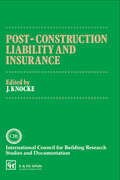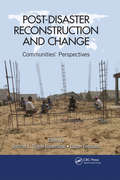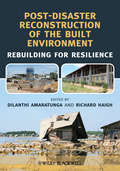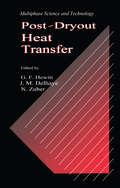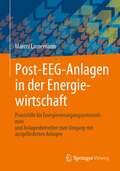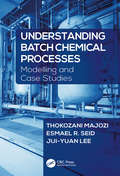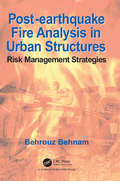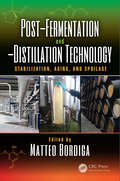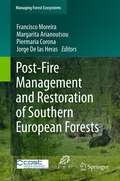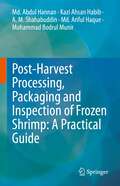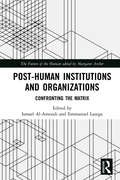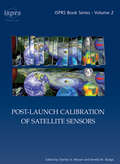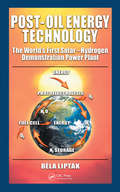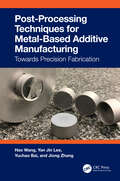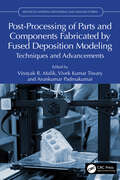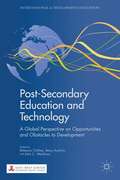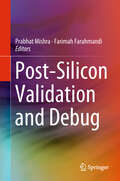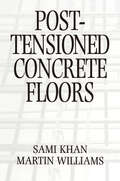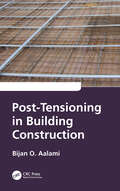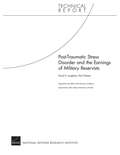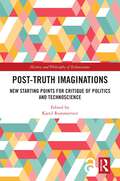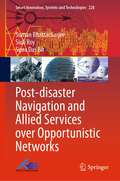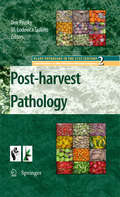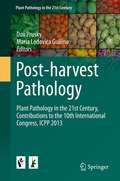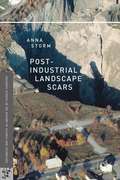- Table View
- List View
Post-Construction Liability and Insurance
by J. KnockeWith the single European market and the growing internationalisation of the work of architects, engineers and contractors it is important for professionals to be aware of the liability provisions of legal systems around the world. An essential reference for lawyers and insurance companies, especially in construction law and insurance, this is required reading for construction professionals involved in international work.
Post-Disaster Reconstruction and Change: Communities' Perspectives
by Jennifer E. Duyne Barenstein Esther LeemannSuccessful recovery following a disaster depends upon transcending the disciplinary divides of architecture, engineering, and planning and emphasizing the importance of community perspectives in the post-disaster reconstruction process. Effective results in community recovery mandate that we holistically examine the complex interrelationship betwee
Post-Disaster Reconstruction of the Built Environment: Rebuilding for Resilience
by Dilanthi Amaratunga Richard HaighDisasters threaten all parts of the world and they appear to be increasing in frequency, scale and intensity. Despite huge improvements in the emergency response, permanent reconstruction is often uncoordinated, inefficiently managed and slow to begin. International agencies are geared to an efficient response in terms of humanitarian relief, but they are not well versed in the requirements of long-term reconstruction, which is often constrained by lack of planning and poorly coordinated management. The construction industry is typically engaged in a range of critical activities after a disaster, including provision of temporary shelter in the immediate aftermath and restoration of permanent shelter and public infrastructure once the immediate humanitarian needs have been attended to. Post-Disaster Reconstruction of the Built Environment identifies the challenges that face the industry and highlights best practice to enable the construction industry to address those problems which make an effective response to these unexpected events difficult. Written by an international team of experts, this book will help researchers and advanced students of construction understand the problems faced by communities and the construction industry when faced with a natural or man-made disaster, and identify the planning and management processes required by the industry to mount an effective response.
Post-Dryout Heat Transfer (Multiphase Science And Technology Ser.)
by G.F. HewittThe study of post-dryout heat transfer has generated great interest because of its importance in determining maximum clad temperature in nuclear reactor loss-of-coolant accidents (LOCAs). An associated phenomenon, the deterioration of heat transfer in boiling, is significant to other industrial sectors. This book provides comprehensive coverage of post-dryout heat transfer, discussing such essential topics as post-dryout heat transfer in dispersed flow, interpretation and use of transient data in surface rewetting by reinstatement of flow or by reducing heat flux, rod bundles, two-phase flow occurrences in the post-dryout region, various methods for predicting ""inverted annular flow,"" and new experiments for measuring thermodynamic nonequilibrium with probes in the channel. The book also presents a basis for independent safety assessment of nuclear reactors and chemical plant systems where post-dryout heat transfer may occur. Post-Dryout Heat Transfer will be a useful reference for researchers and professionals in the nuclear and chemical production industries.
Post-EEG-Anlagen in der Energiewirtschaft: Praxishilfe für Energieversorgungsunternehmen und Anlagenbetreiber zum Umgang mit ausgeförderten Anlagen
by Marcel LinnemannBetreiber von Anlagen, die unter das EEG fallen, werden vor der Frage stehen, wie der weitere Betrieb sicherzustellen ist. Dieses Buch zeigt die Möglichkeiten zur Vermarktung solcher Anlagen für Energieversorger und Anlagenbetreiber auf, bespricht die Hintergründe sowie die Vertragsgestaltung. Messkonzepte für unterschiedliche Vermarktungskonzepte (Volleinspeisung, Überschusseinspeisung) sowie die regulatorische Einordung (Steuern, EEG Umlage ect.) sind ebenso berücksichtigt.
Post-Earthquake Fire Analysis in Urban Structures: Risk Management Strategies
by Behrouz BehnamPost-earthquake fire is one of the most complicated problems resulting from earthquakes and presents a serious risk to urban structures. Most standards and codes ignore the possibility of post-earthquake fire; thus it is not factored in when determining the ability of buildings to withstand load. This book describes the effects of post-earthquake fire on partially damaged buildings located in seismic urban regions. The book quantifies the level of associated post-earthquake fire effects, and discusses methods for mitigating the risk at both the macro scale and micro scale. The macro scale strategies address urban regions while the micro scale strategies address building structures, covering both existing buildings and those that are yet to be designed.
Post-Earthquake Fire Analysis in Urban Structures: Risk Management Strategies
by Behrouz BehnamPost-earthquake fire is one of the most complicated problems resulting from earthquakes and presents a serious risk to urban structures. Most standards and codes ignore the possibility of post-earthquake fire; thus it is not factored in when determining the ability of buildings to withstand load. This book describes the effects of post-earthquake fire on partially damaged buildings located in seismic urban regions. The book quantifies the level of associated post-earthquake fire effects, and discusses methods for mitigating the risk at both the macro scale and micro scale. The macro scale strategies address urban regions while the micro scale strategies address building structures, covering both existing buildings and those that are yet to be designed.
Post-Fermentation and -Distillation Technology: Stabilization, Aging, and Spoilage
by Matteo BordigaWhile most wine and spirits books focus on vineyard and crop management or fermentation and distillation processes, few address critical post process aspects of stabilization, aging, and spoilage. This book serves as a comprehensive source of information on post-fermentation and -distillation technology applied to wine, beer, vinegar and distillates in a broad spectrum. Post-Fermentation and -Distillation Technology: Stabilization, Aging, and Spoilage thoroughly describes all of the operations related to these products after the fermentation or distillation steps, focusing on the complex issues related to their stabilization, aging, and spoilage. The final product must be stable against microbial activity as well as undesirable chemical and physical chemical reactions that occur in the bottle. For example, clarity, stability, compositional adjustment, style development and packaging represent the five goals of "finishing" a wine. Concerning the visual defects associated with spoilage, it is crucial that wine at the point of consumption not be cloudy or contain any haze or precipitate, especially white wines. Similarly, it is also important to prevent unwanted microbial growth from occurring in the wine after the primary fermentation is complete, affecting the flavor and aroma profile in unpredicted ways. The book addresses all of these issues and more. Moreover, the discussion also involves beer, vinegar and distillates, giving this book a novel and interesting approach. The book combines referenced research with practical applications and case studies of novel technologies such as square barrels, synthetic closures, and Tetra Pak®.
Post-Fire Management and Restoration of Southern European Forests
by Piermaria Corona Francisco Moreira Margarita Arianoutsou Jorge De las HerasIn spite of all the efforts made in fire prevention and suppression, every year about 45 000 forest fires occur in Europe, burning ca. 0.5 million hectares of forests and other rural lands. The management of these burned forests has been given much less attention than fire prevention or fire suppression issues, but the post-fire management of burned areas raises strong concerns (economic and social impacts, soil erosion and water quality, biodiversity loss, forest restoration). Although there are a few publications which address post-fire management, the focus of these has been either on general approaches to restoration or specific topics such as preventing post-fire soil erosion. This book is about the post-fire management of fire-prone forest types in southern Europe. It provides the first comprehensive overview of the topic, ranging from stand-level to landscape-level management, and from emergency actions to long-term restoration approaches.
Post-Harvest Processing, Packaging and Inspection of Frozen Shrimp: A Practical Guide
by Md. Abdul Hannan Kazi Ahsan Habib A. M. Shahabuddin Md. Ariful Haque Mohammad Bodrul MunirThe book is a practical guide for the various steps in the post-harvest technology of frozen shrimps. Shrimps are one of the most common and popular types of seafood consumed globally. The book discusses some of the most sought-after shrimps such as Penaeus monodon, P. vannamei, and Macrobrachium rosenbergii. Good-quality shrimp is a prerequisite for the seafood business as it is used for human consumption. Lack of proper knowledge in raw materials handling and post-harvest processing is the main obstacle in quality shrimp production. Complex business policy, commitment break in both parties (buyers and sellers), competition with other seafood-producing countries, and fluctuation of currency in international seafood market are the factors affecting international seafood business. This book closes this gap in literature and facilitates the production of excellent-quality exportable frozen shrimp through informed practices from experts. The book includes information about packaging of frozen shrimp, inspection, and shipment. It also compiles different mathematical calculations which are in practiced in the processing industries. The book is essential reading for professionals in the shrimp producing and processing industries. It is also useful for researchers in fisheries science, aquaculture, food technology, and food microbiology.
Post-Human Institutions and Organizations: Confronting the Matrix (The Future of the Human)
by Ismael Al-Amoudi; Emmanuel LazegaWhen the Matrix trilogy was published in the mid-1980s, it introduced to mass culture a number of post-human tropes about the conscious machines that have haunted our collective imaginaries ever since. This volume explores the social representations and significance of technological developments – especially AI and human enhancement – that have started to transform our human agency. It uses these developments to revisit theories of the human mind and its essential characteristics: a first-person perspective, concerns and reflexivity. It looks at how the smart machines are used as agents of change in the basic institutions and organisations that hold contemporary societies together, for example in the family and the household, in commercial corporations, in health institutions or in the military. Its main purpose is to enrich the ongoing public discussion of the social and political implications of the smart machines by looking at the extent to which they further digitalise and bureaucratise the world, in particular by asking whether they are used to develop techno-totalitarian societies that corrode normativity and solidarity.
Post-Launch Calibration of Satellite Sensors: Proceedings of the International Workshop on Radiometric and Geometric Calibration, December 2003, Mississippi, USA. (ISPRS Book Series)
by Stanley A. Morain Amelia M. BudgeIncreasingly, in the field of earth observation imagery, there is a need for image quality to be assessable in traceable Standard International Units (SIU), and for the standardization of common mapping projections. These two needs, plus the increased usage of combinations of data and image types, provided the stimuli for the development of this im
Post-Oil Energy Technology: The World's First Solar-Hydrogen Demonstration Power Plant
by Bela G. LiptakA solution to the climate and energy crisisThe reversible fuel cell (RFC) described in this volume stores solar energy and thereby makes it continuously available. This can make the building of energy-free homes and all electric transportation a reality. The foldout drawing at the back of this book also describes the detailed design of the world’s first 1,000 megawatt solar-hydrogen power plant. How is this possible?Our planet receives more solar energy in an hour than humans use in a year. In fact, 5% of the Sahara could meet the total energy requirement of mankind. This energy can then be stored and transported in the form of hydrogen. Converting from an exhaustible energy economy to a clean, free, and inexhaustible oneIn this timely book, author Béla Lipták explains why a solar-hydrogen economy is technically feasible and cost-effective. He first outlines existing conservation technologies and renewable energy processes as well as evolving technologies, such as energy-free homes, roof shingle solar collectors, and RFCs. He goes on to discuss energy optimization techniques that could reduce the global energy consumption by one third and finally presents the detailed design of a full size solar-hydrogen power plant. It is time to harness the power of solar energyWith global energy consumption quadrupling in the last fifty years and atmospheric carbon dioxide reaching the highest level ever recorded, now is the time to prevent further damage to the planet and ensure the survival of human civilization. It is debatable how much time we have before our fossil and uranium deposits are exhausted. It is also debatable how much climate change we can live with or how much of our economic resources should be devoted to stabilizing and reversing mankind’s growing carbon footprint. What is not debatable is that our resources are exhaustible and that we must not give reason for our grandchildren to ask, "Why did you not act in time?".
Post-Processing Techniques for Metal-Based Additive Manufacturing: Towards Precision Fabrication
by Hao Wang Yan Jin Lee Yuchao Bai Jiong ZhangThis book shares insights on post-processing techniques adopted to achieve precision-grade surfaces of additive manufactured metals including material characterization techniques and the identified material properties. Post-processes are discussed from support structure removal and heat treatment to the material removal processes including hybrid manufacturing. Also discussed are case studies on unique applications of additive manufactured metals as an exemplary of the considerations taken during post-processing design and selection. Addresses the critical aspect of post-processing for metal additive manufacturing Provides systematic introduction of pertinent materials Demonstrates post-process technique selection with the enhanced understanding of material characterization methods and evaluation Includes in-depth validation of ultra-precision machining technology Reviews precision fabrication of industrial-grade titanium alloys, steels, and aluminium alloys, with additive manufacturing technology The book is aimed at researchers, professionals, and graduate students in advanced manufacturing, additive manufacturing, machining, and materials processing.
Post-Processing of Parts and Components Fabricated by Fused Deposition Modeling: Techniques and Advancements (Advanced Materials Processing and Manufacturing)
by Vinayak R. Malik Vivek Kumar Tiwary Padmakumar ArunkumarThis book describes several post-processing techniques that can be used to enhance the mechanical strength, isotropy, surface quality, and dimensional accuracy of 3D printed components using the Fused Deposition Modeling (FDM) technique. It also discusses the usage of adhesives, interlocks, fasteners, ultrasonic, frictional, and microwave energy to join FDM-3D printed parts. Furthermore, the book also covers the scope of future research and challenges in the post-processing of FDM parts, as well as some of the most popular approaches in the field, such as Big Area Additive Manufacturing (BAAM), Machine Learning, and Internet of Things (IoT).Features:• Covers all necessary details related to post-processing of Fused Deposition Modeling (FDM) parts.• Provides an overview of various joining techniques for 3D printed FDM parts.• Focuses on the latest developments related to sustainability and optimization in post-processing of FDM parts.• Includes microwave joining of 3D printed parts.• Reviews case studies on cutting edge research, innovation, and development aspects.This book is aimed at researchers and graduate students in additive manufacturing, materials science, as well as manufacturing engineering.
Post-Secondary Education and Technology
by Rebecca Clothey Stacy Austin-Li John C. WeidmanAs the global commitment to educational access has become enshrined in all levels of society, new technologies have also been developed that hold tremendous promise for enabling these goals. This book looks at trends and challenges for expanding access to post-secondary education via technology through a set of case studies and analyses.
Post-Silicon Validation and Debug
by Prabhat Mishra Farimah FarahmandiThis book provides a comprehensive coverage of System-on-Chip (SoC) post-silicon validation and debug challenges and state-of-the-art solutions with contributions from SoC designers, academic researchers as well as SoC verification experts. The readers will get a clear understanding of the existing debug infrastructure and how they can be effectively utilized to verify and debug SoCs.
Post-Tensioned Concrete Floors
by Martin Williams Sami KhanPost-tensioning is the most versatile form of pre-stressing, a technique which enables engineers to make the most effective use of the material properties of concrete, and so to design structural elements which are strong, slender and efficient. Design in post-tensioned concrete is not difficult and, if done properly, can contribute significantly t
Post-Tensioning in Building Construction
by Bijan O. AalamiWorldwide growth and application of post-tensioning in recent years is one of the major developments in building construction. The growth is propelled by a burgeoning demand for construction of serviceable and safe buildings. Unlike traditional construction, post-tensioning is based on new design methodology often not covered in traditional engineering courses. With more than 40 years of experience of study, teaching and work on post-tensioning applications around the world, the author has written this book for students as well as practicing engineers, contractors and academics. While the book covers the basics and concepts of post-tensioning in simple and clear language, it also focuses on the application and detailed design through real world examples. Topics of the book include the European and the American building Codes for post-tensioning design. The codes are detailed in the book’s examples such as column-supported floors and beam frames. The book explains and highlights the importance of shortening specific to post-tensioned members and construction detailing for serviceable and safe performance.
Post-Traumatic Stress Disorder and the Earnings of Military Reservists
by Paul Heaton David S. LoughranAn investigation of the effects of having symptoms of post-traumatic stress disorder (PTSD) on the labor market earnings of reservists in the years following deployment.
Post-Truth Imaginations: New Starting Points for Critique of Politics and Technoscience (History and Philosophy of Technoscience)
by Kjetil RommetveitThis book engages with post-truth as a problem of societal order and for scholarly analysis. It claims that post-truth discourse is more deeply entangled with main Western imaginations of knowledge societies than commonly recognised. Scholarly responses to post-truth have not fully addressed these entanglements, treating them either as something to be morally condemned or as accusations against which scholars have to defend themselves (for having somehow contributed to it). Aiming for wider problematisations, the authors of this book use post-truth to open scholarly and societal assumptions to critical scrutiny. Contributions are both conceptual and empirical, dealing with topics such as: the role of truth in public; deep penetrations of ICTs into main societal institutions; the politics of time in neoliberalism; shifting boundaries between fact – value, politics – science, nature – culture; and the importance of critique for public truth-telling. Case studies range from the politics of nuclear power and election meddling in the UK, over smart technologies and techno-regulation in Europe, to renewables in Australia. The book ends where the Corona story begins: as intensifications of Modernity’s complex dynamics, requiring new starting points for critique.
Post-disaster Navigation and Allied Services over Opportunistic Networks (Smart Innovation, Systems and Technologies #228)
by Siuli Roy Sipra Das Bit Suman BhattacharjeeThis book provides the details of developing a digital pedestrian map construction system over the intermittently connected mobile network. Over the past couple of decades, countries across the world, both developing and developed, have witnessed a significant number of disasters. Thus, it has become mandatory for each of the disaster-prone countries to equip themselves with appropriate measures to cope with the challenges of providing post-disaster services. Some of the serious challenges are incapacitated communication infrastructure, unstable power supply and inaccessible road networks. Out of these challenges, the destruction of road networks, especially in developing countries, acts as a major hindrance to effective disaster management. To be more specific, the success of a disaster response operation generally depends on the speed of evacuation and transportation of adequate amount of relief materials at the right time to the disaster-affected areas. Hence, map-based navigation support is a primary requirement for post-disaster relief operations. This book also provides the solution of the two other important post-disaster management services such as situational awareness and resource allocation. Both of these services are invariably dependent on the existence of navigation support. Finally, in order to offer such services, the other challenge is to address the problem of incapacitated communication infrastructure. This book also deals with such challenges in post-disaster scenarios and develops automated post-disaster management services.
Post-harvest Pathology: 2 (Plant Pathology in the 21st Century)
by Maria Lodovica Gullino Dov PruskyAs a collection of papers that includes material presented at the 2008 International Congress for Plant Pathology, this text features research right at the leading edge of the field. The latest findings are particularly crucial in their implications for fruit production; an important market sector where in some areas up to 50 per cent of the crop can be lost after harvest. While post-harvest fruit treatments with fungicides are the most effective means to reduce decay, rising concerns about toxicity have led to the development of alternative approaches to disease control, including biological methods, the subject of three chapters of this book. With several new techniques requiring modification of current post-harvest practices, it is more important than ever to stay abreast of the latest information. Other chapters deal with the mechanisms of host fruit and vegetable resistance, fungal pathogenicity factors and their relationship with the host response, and a number of subjects related to disease assessments before harvest as well as their relationship to the postharvest treatment of fruits and vegetables. The book also includes several useful case studies of crops such as kiwifruit and peaches, where different approaches at the pre- and post-harvest levels are combined to good effect. With food production issues gaining an ever higher profile internationally, this text makes an important contribution to the debate.
Post-harvest Pathology: Plant Pathology in the 21st Century, Contributions to the 10th International Congress, ICPP 2013
by Maria Lodovica Gullino Dov PruskyThis collection of papers includes some of the presentation given at the International congress of Plant Pathology held in Beijing in 2013 in the session of Recent Development in Postharvest Pathology. Fruit production for human consumption is an important part of the market economy. Any waste during to spoilage and pest infestation, in the field and the postharvest phase, results in significant economic losses which are more pronounced as the losses occur closer to the time of produce sale. Careful handling of perishable produce is needed for the prevention of postharvest diseases at different stages during harvesting. Handling, transport and storage in order to preserve the high quality produce. The extent of postharvest losses varies markedly depending on the commodities and country estimated to range between 4 and 8% in countries where postharvest refrigeration facilities are well developed to 30% where facilities are minimal. Microbial decay is one of the main factors that determine losses compromising the quality of the fresh produce. For the development of an integrated approach for decay management, cultural, preharvest, harvest and postharvest practices should be regarded as essential components that influence the complex interactions between host, pathogen, and environmental conditions. Orchards practices including preharvest fungicide applications can also directly reduce the development of postharvest fruit decay. Among postharvest practices, postharvest fruit treatments with fungicide are the most effective means to reduce decay. Ideally, these fungicides protect the fruit from infections that occur before treatment, including pathogen causing quiescent infections, as well from infection that are initiated after treatment during postharvest handling, shipment and marketing. The implementation of these alternatives techniques often requires modifying currently used postharvest practices and development of new formulation for their applications. The present chapters deal with the newest report related to postharvest pathology in the world.
Post-industrial Landscape Scars
by Anna StormPost-industrial landscape scars are traces of 20th century utopian visions of society; they relate to fear and resistance expressed by popular movements and to relations between industrial workers and those in power. The metaphor of the scar pinpoints the inherent ambiguity of memory work by signifying both positive and negative experiences, as well as the contemporary challenges of living with these physical and mental marks. In this book, Anna Storm explores post-industrial landscape scars caused by nuclear power production, mining, and iron and steel industry in Malmberget, Kiruna, Barseb#65533;ck and Avesta in Sweden; Ignalina and Visaginas/Snie'kus in Lithuania/former Soviet Union; and Duisburg in the Ruhr district of Germany. The scars are shaped by time and geographical scale; they carry the vestiges of life and work, of community spirit and hope, of betrayed dreams and repressive hierarchical structures. What is critical, Storm concludes, is the search for a legitimate politics of memory. The meanings of the scars must be acknowledged. Past and present experiences must be shared in order shape new understandings of old places.
